Going Nowhere In Full Afterburner In An F-16
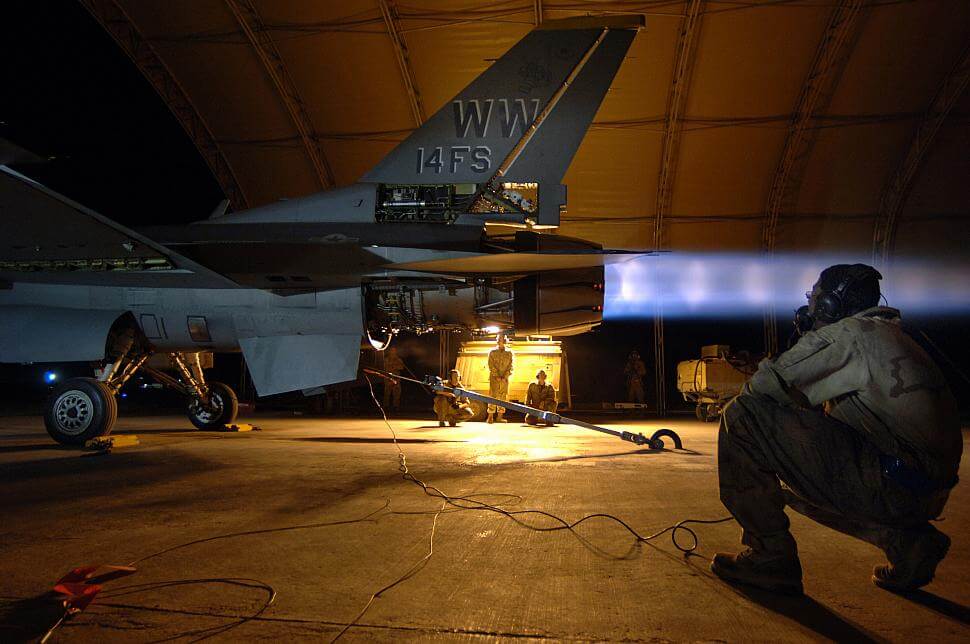
By Mitchell Boling
Adapted from his book, “Leadership: A View From The Middle”
Copyright (C) 2019. Reprinted with Permission.
I had a very exciting experience early in my career while stationed with the 36th Fighter Squadron “Flying Fiends” at Osan Air Base, Republic of Korea.
As a U.S. Air Force Staff Sergeant and fledgling leader/supervisor, I had volunteered and was accepted to learn how to operate the F-16 engine.
A lot of fellow maintainers shirked the thought of becoming an “Engine Run Guy,” because it usually involved working longer hours outside of one’s normal daily duties. But I eagerly accepted this responsibility because I wanted to learn more about the F-16, and mostly, because running that engine was completely outside of my comfort zone. It also looked to be a very exciting and fun task, so I was very happy that I was selected.
Running engines and performing engine maintenance was the responsibility of the engine mechanics and aircraft crew chiefs.
I was selected because of the need for someone with my particular skillset to become qualified.
As an avionics specialist, I would normally troubleshoot and operate my systems via the application of external electrical power. Avionics guys would very rarely need to troubleshoot their systems during an engine run.
However, there were times when it was extremely helpful to have someone in the cockpit of a running aircraft who knew how to interpret an avionics system’s data.
The digital flight control system was one of those systems. It was a challenge to talk someone through flight controls troubleshooting who had no familiarity to access the necessary cockpit displays, let alone find the right screen and interpret the data. So, I was called upon to fill this gap.
The training took about a week, and it included a couple of days in the classroom, a day in the F-16 simulator, and finally running an actual jet.
The classroom days were mostly spent learning the intricacies of the engine and the cockpit instruments which monitor engine performance. In addition to learning the actual steps of starting and then shutting down the engine, the most important thing we learned was how to perform the emergency shut down procedures. In the event of a fire or some other emergency involving the engine, we learned how to rapidly shut it down and evacuate the aircraft.
Once classroom training was complete, we met at the simulator facility for practice.
This was my first time in an aircraft simulator, and it was pretty interesting.
It was a cockpit with all of the switches and displays required to “fly” the jet, and an immersive 360-degree visual system that replicated the outside world. In an adjacent room, the instructor sat at a computer station with the simulator operator and conducted the training.
From here, he could inject faults into the simulator which would depict engine failures on the aircraft. These failures were meant to prompt me to perform the emergency shut down procedures.
He would also talk to me over an intercom, and play the role of the crew chief who assists in starting the aircraft from the outside.
I climbed into the cockpit and positioned an eight-inch octagonal “stop sign” in front of the head up display glass, which was about eighteen inches in front of my face. On the stop sign was a short list of steps required to shut down the engine in the event of an emergency.
I also had my technical orders, the book of actual procedures, in my lap, but this sign was a good “at a glance” way to shut down the engine safely during an emergency.
My first couple of starts went okay, and I watched the gauges as the engine spooled up to idle speed.
Engine revolutions per minute or RPM, temperature, nozzle, oil pressure and hydraulics instruments all moved up to their operating parameters.
I could see when the generator came on line, which enabled all of the lights and avionics systems to come alive.
I received no physical feedback though, as this cockpit was not able to simulate the rumble of the jet as it spooled up. Still pretty cool, but then he injected a fault.
My third start seemed to be going fine, but the engine didn’t seem to want to spool up quite as quickly as the first two times.
I started scanning the gauges again, and noticed the RPM gauge stagnating and beginning to go back toward zero. Then, the red “eyebrow” warning light illuminated, reading FIRE.
This fire warning light had come on a few seconds after the ENGINE HOT caution light lit up. I hadn’t noticed them in time, because I was trying to figure out why the gauges weren’t responding correctly. I was on fire!
I notified the instructor and began my emergency shut down sequence. When it was complete, I got out of the cockpit so another student could take his turn. I made my way into the control room where the simulator operator, instructor, and other students were sitting.
They all started laughing at me as I walked through the door.
“Well, you were the slowest one yet,” said the instructor as he laughed.
“Yeah, I didn’t see the fire light until it was too late,” I replied. “I guess my aircraft burned down.”
“Heck, not only did you burn your aircraft down, but you burned this simulator facility down, and all of the buildings on this side of base, before you finally recognized that you were on fire.”
Tough crowd. They all began laughing again and poking fun at me while the next student was getting ready for his turn. I took it in stride, but it was a little daunting to be with these folks.
Traditionally, getting a “run license” was only reserved for engine mechanics and crew chiefs. They didn’t necessarily agree with the “big picture” of why someone in my career field was learning their task.
I was intruding on their territory, and they let me have it, more than usual.
Aircraft maintainers have always had a friendly rivalry with those from the other career fields, and would constantly take swipes at one another with little mercy. We called each other Pointy Heads and Booger Hookers. But in the end, we all knew our roles of what we needed to do to keep the aircraft flying. We were all from the same brotherhood of aircraft maintenance, and accepted each other for what we contributed to the mission.
I was proud to be a Pointy Head!
Next came actually starting an aircraft for the first time.
We met at the Hush House, which is a hangar with extra baffling inside the walls that helps to keep the noise of the jet engine to a minimum when heard from outside of the building. It also had a two-hundred foot long tunnel with an angled blast wall at the end that would channel the jet engine exhaust out of the house.
It is here, inside the hush house, where aircraft maintainers can run the F-16 in full afterburner.
Afterburner operation occurs when raw jet fuel is injected into the engine augmenter, resulting in a long cone of fire out of the exhaust and twenty-eight thousand pounds of thrust, angrily pushing against the airframe.
This afterburner-augmented aircraft produces noise levels rising above two hundred decibels while operating in full afterburner. In comparison, a typical rock concert produces decibel levels near one hundred and twenty.
This experience was going to be exciting, albeit with a squadron of butterflies in my stomach.
We arrived just as the aircraft was being towed into place. A two-seat F-16D model was being prepped for our training.
The crew chiefs backed the aircraft into the hush house and disconnected the tow bar from the nose tire. The aircraft was positioned in front a giant chain link that was permanently embedded into the floor.
Next, a heavy-duty steel tie down was connected between the aircraft tail hook and the chain link.
We students then went out to the aircraft and walked through our pre engine-start checklist. This involved thoroughly inspecting the aircraft and the engine to ensure it was full of gas and oil, there were no fail indicators on the filters, etc.
Someone also put on a “bunny suit” and jumped down the intake to perform an engine blade inspection, looking for damage and any loose items that could cause catastrophic damage to the engine.
Once complete, the final step was installing the “anti-personnel” cage, which was a large, red metal cage that was fitted onto the lip of the intake to the engine.
The anti-personnel cage was exactly that, a cage that kept any personnel from becoming sucked down the intake and literally being eaten by the engine.
Some of the initial training books that I had read years earlier, stated that if a person went down the intake while the engine was running, a red mist would exit the exhaust. All maintainers took this to heart, for sure. It has happened before, and nobody wanted to die like that.
With all of the prep work done, it was time to close the massive concrete and steel hush house doors and fire up the engine.
The instructor climbed into the rear seat and I climbed into the front and put my communication headsets on.
I placed my stop sign in front of me and closed the canopy, locking it in place with the large yellow handle.
I moved the throttle with my left hand all the way up through afterburner and back to cutoff to check for binding.
Next, I turned on the battery and made sure communications were good between me, the instructor and the crew chief on the ground.
I turned on the radio and called the airfield ground operations to ask for permission to start. Every engine start, whether it was by a maintainer or a pilot, had to have permission to proceed.
After receiving my permission, I placed the Jet Fuel Starter or JFS, switch to Start 2. The intake and exhaust doors opened on the left side of the fuselage and the JFS began operating.
The JFS is in itself a small jet engine, used to start spooling up the powerful General Electric GE-110 engine.
I monitored the RPM, temperature, hydraulic and oil gauges as the engine began waking up. Once the JFS reached its peak and the engine RPM arrived at the correct percentage, I went over the horn with the throttle, advancing forward from cutoff and into idle.
With this introduction of fuel, the engine immediately began a low rumble that I felt in the seat of my pants. This was called the light off, as the engine started working on its own.
The JFS automatically shut down and its doors closed.
I continued to scan the instruments, looking for any signs of stall, stagnation or fire.
Everything was going fine, and at one point the aircraft generator came on line.
Once this occurred, all of the other instruments, cockpit displays and flood lighting came to life.
Finally, the engine settled in to its nominal RPM, and the start was complete. We were now running at idle.
The only things I noticed from inside the cockpit as a result of the engine start was the small rumble as the engine lit off, a faint buzzing from the intercom, and the loud blowing of the environmental control system or ECS.
The ECS is the air conditioning system for the aircraft. A quick twist of the blower duct and the airflow calmed down a little bit.
We ran for five minutes at idle power to let the engine warm up.
Once warmed up, it had become time to push it into afterburner.
The crew chief kicked the wooden chocks out from in front of the main landing gear tires. The only thing holding us back at that point was the tail hook attached to the ground.
The instructor asked me to advance the throttle to military power, eighty percent RPM.
As I pushed the throttle forward to the firewall, I felt the nose of the aircraft settle slightly. The ECS started blowing a little bit harder and the engine instruments moved a little bit.
Outside, the exhaust nozzle, otherwise known as the “turkey feathers,” closed down to its smallest point as we transitioned to eighty percent RPM. The nozzle was now less than two feet in diameter, effectively squelching the exhaust orifice and adding tremendous back pressure to the aircraft.
This produced a massive amount of thrust on the airframe as we strained against the tail hook.
Once we were stabilized at this power setting, the crew chief went back under the jet and replaced the chocks behind the tires.
Next, I as moved back into idle power, the aircraft stood still, unable to move forward or backward. It had become mechanically frozen in place, held back by the tail hook only, and held forward by the wheel chocks.
We were now ready to light the burner.
This was going to be exciting, I thought nervously.
I advanced the throttle back into military power for a few seconds.
Once it had stabilized, I tilted the throttle grip inboard to release it from the firewall, and pushed it farther up into the first stage of afterburner. I hesitated for a moment as I felt the afterburner thump, and then slowly advanced the throttle to one hundred percent, full afterburner.
Only a few things were different from running at idle, which I found to be fascinating.
The first indication to me that I was in afterburner was the nozzle indicator had transitioned from one hundred percent closed in military thrust, to one hundred percent open, in full afterburner.
The second indication was the fuel flow indicator, which looks like an odometer, had moved from twelve hundred pounds of fuel consumed per hour at idle, to forty-four thousand pounds per hour.
Finally, I noticed the aircraft had settled down a little more onto its nose gear strut, and the front of the aircraft slowly swayed several inches from side to side, straining mightily against the tail hook chained to the floor.
We were now running in full afterburner power. I couldn’t see it, but a massive cone of fire was exiting my aircraft and blowing down the hush house exhaust tunnel, with the only thing holding us back being a little hook. It was amazing.
What a rush!
The things that amazed me the most were the lack of noise inside the cockpit, comparative to the noise the aircraft was producing, and the sight of a giant concrete and steel wall, twenty feet off my nose!
Finished with the afterburner run, I placed the throttle back into idle for a five-minute cool down. And then I performed the shutdown procedure so the next student could get in and have some fun.
This was the one and only time I had run in the hush house in afterburner.
All of the engine runs I subsequently performed were in idle and sometimes up to eighty percent, which was the highest level one could go without having to be in the hush house.
Now that I had my run license, I could begin assisting the crew chiefs and engine mechanics perform troubleshooting and operational checkouts on the F-16.
One time, we had a peculiar problem on an aircraft which required my unique skill set.
I worked on the swing shift, which ran from three in the afternoon until midnight or so.
One of our aircraft had reported an engine problem in flight and had to divert to another air base in Korea.
The problem was that whenever the pilot would talk on his primary radio, the engine RPM would decrease a little bit.
Talking on the radio involved pushing a microphone switch that was located on the engine’s throttle grip.
With all of the wiring running through this “electric jet,” it was conceivable that something like this could occur.
Because I was an avionics guy with a run license, I would be the one to travel to the other base to troubleshoot this aircraft, which diverted at about eight o’clock that night.
The base where it landed, Kunsan Air Base, was four hours away by truck so we gathered our equipment and headed out.
With me was the Pro Super, who would be our maintenance overseer, and one of my coworkers to act as the crew chief and co-troubleshooter on the aircraft.
It took us a little time to gather our tools and get on the road, but we had a quick drive down there, arriving in about three hours.
By one in the morning we had checked in with the local flight line supervision and were at the aircraft.
We quickly began getting it ready for an engine run.
I put on my bunny suit and jumped down the tube to inspect the engine blades.
Afterward, I climbed out and installed the red anti-personnel cage onto the intake.
The aircraft was parked on the visiting aircraft ramp, out under the stars.
By two in the morning when we were ready to start the engine, I noticed that a storm had been building on the horizon, out over the ocean.
As I closed the canopy, I could see the clouds lighting up and flashing as the storm moved our way.
I radioed the local ground operations for permission to run, and began the process of starting the engine.
My coworker, acting as the crew chief, would be talking to me on the intercom the entire time.
The pro super, a career crew chief himself, was acting as fire guard, watching intently.
I started the JFS and watched the engine instruments as they rose accordingly.
When the instruments were at the right point, I advanced the throttle to idle. At the same instant when the engine lit off and I felt the rumble in my seat, a lightning bolt flashed out of the clouds above my head and extended its electrified fingers along the length of my canopy.
I kind of jumped, startled, but quickly noticed it was nothing if not a really cool moment. Lightning bolts flashing over my head while simultaneously feeling the rumble of my F-16 engine cranking up. Cool!
We began troubleshooting the engine and radio problems.
Unfortunately, we couldn’t find anything wrong.
I moved the throttle above idle a few times to see if that would trigger the problem, but it did not.
We needed to experience the problem so we would know how to proceed. If we couldn’t duplicate the problem, a decision would have to be made on whether to continue and do more invasive troubleshooting, or gain permission to have the pilot fly it home as is.
That decision is actually pretty commonplace in aircraft maintenance, returning an aircraft to service because a problem could not be duplicated during troubleshooting.
However, when it came to an engine or flight controls problem that could not be duplicated, the level of decision-making had to rise.
Several minutes later, it still would not duplicate and we were getting close to being out of options.
I told my coworker that I wanted to go to eighty percent, military power for a few moments.
“Mitch, you know we’re in quiet hours, right?”
Quiet hours started at ten at night and extended until seven in the morning. This meant that engine runs could not go past idle, especially not up into military power.
I had already broken that rule by advancing out of idle power a few times while troubleshooting.
“Yeah I know, but we can’t duplicate the problem, Rico. I need to push it up.”
I continued, “Go set the chocks a little bit tighter into the tires, would you? Oh, and tell Super what we’re planning to do.”
Rico went over to the pro super and shouted to him into his ear defenders, over the noise of the idling aircraft, our plans.
He just smiled and shrugged his shoulders. He knew what was at stake.
Rico got back on the intercom. “Okay, Super knows what you’re going to do.” He continued, “I hope we don’t get into trouble.”
We were ready. I scanned the cockpit to ensure all of the gauges looked good, stood on the brakes and took a quick breath.
I told Rico, “What are they gonna do, send me to Korea?” and quickly advanced the throttle up into military power, waking up Koreans for miles around.
I only kept it there for a few moments, but I immediately got a radio call from ground operations ordering me to stop the noise.
I couldn’t duplicate the problem at military power so I went back to idle.
I tried it one more time with no luck (might as well, everyone was already awake), and eventually shut down the engine without duplicating the problem.
I didn’t get into any trouble, although I think we had quickly worn out our welcome.
We had a good feeling on what component should fix the problem, though. We also knew that we would not be able to replace it that night, because doing so would involve tearing apart the cockpit.
With no hangar space available and a storm rolling in, our only choice was to leave it for later.
We decided to close it down for the night and put the jet to bed. Commanders do not like “leaving it for later,” however.
The super got on the phone and discussed options with the maintenance supervisors at the home base.
He relayed our recommendation on what component to replace, as well as pointing out that the aircraft did have a backup radio to use instead of the one that had interfered with the operation of the engine. This would allow the jet to safely fly, if that decision were to be made.
We checked in to our lodging quarters on base at about four in the morning for a quick nap.
We met back up at nine in the morning and found that the aircraft was already gone, having been launched by the local transient alert crew chiefs.
After the pro super’s discussion with his supervisors, the wing commander decided to authorize a one-time-flight back home, where more extensive troubleshooting could take place.
Since we could not duplicate the malfunction and all systems worked properly, it was an easy decision to let the aircraft fly directly home without using the primary radio.
Later that afternoon when we got back to Osan, we learned that the aircraft had made it back safely. It had already been repaired, by replacing the component that we suggested.
As we drove across the flight line toward our building where we would return our tools and equipment, we saw that the aircraft was parked in its regular spot, ready to meet whatever mission it was assigned that day.
As they say at Osan, “Ready to Fight Tonight!”
This story followed two different mission statements:
The first mission statement was my personal mission statement at the time, which was to do whatever it takes to get the job done.
Although I had never verbalized or written this down as a personal mission statement, it was true, really.
It was how I worked, and it was how we all worked. We had a job in front of us and we had to do it.
This particular job involved getting outside of my comfort zone by learning to run fighter jet engines and then, working around the clock with the others to troubleshoot a failing aircraft.
Together, we did this willingly. We didn’t discuss what our personal mission statements should be, rather, we knew what we had to do to get the job done.
Our mission was to fix the jet so it could fly the next day.
While it turned out that we couldn’t actually effect the repair of the aircraft, we were ready and willing to continue working it, should the commander have decided to keep the aircraft grounded.
The other mission statement was more of an organizational one, an overall, all-encompassing statement that the U. S. military followed.
Organizational mission statements in the military are very wordy in an effort to include all that they are charged with doing.
Although wordy, what our mission statement really boiled down to, was to be ready to fight tonight. This meant that the commander needed to get his warfighting asset back in place, in the name of readiness.
He needed to be able to have his aircraft back in its normal parking spot, repaired and ready to go tonight, if the need had arisen.
The mission statement was not necessarily discussed during the conversation; however, it was something that was universally understood by all involved.
The pro super, his supervisors, and the wing commander all knew that they had to do everything they could to get that aircraft repaired and ready to go. If it meant authorizing a one-time-flight, then so be it.
The commander and all who was involved in this endeavour, had supported the mission statement without having to verbalize it.
All companies should have a mission statement, one that is communicated to each level of the organization.
While it doesn’t have to be verbalized in every meeting, it is something that is shared to all, and then the actions of everyone should be aimed at supporting the statement.
One simple mission statement should be all that is needed, and it should align with the vision of the company.
This vision is when the leaders see how their company should look in the future.
The mission statement explains how it is going to get there.
If the employees buy in to these thoughts, then the mission statement can become the positive mantra of a successful organization.
The same goes for a personal mission statement.
As leaders, if we write out a personal mission statement and then attempt to follow it each day, then we may become more successful in meeting our personal and career goals.
My personal mission statement is:
“By utilizing my technical background and business education, I will provide the leadership knowledge, business acumen, and positive influence required to ensure the achievement of company goals through customer satisfaction.”
We may also need to communicate our personal mission statement to our followers, although not verbatim.
For instance, I’m not going to tell my followers, “Okay gang, let’s all work together and repair that aircraft by using our technical background and business acumen. If we do that, we can achieve our company’s goals!”
No, I won’t say it like that.
Rather, I would lead by example. “Walk the talk” as it were.
I believe that when we live out what our personal mission statement has outlined, then we will become more successful in reaching our personal goals.
As leaders and managers, we will be faced with devising and communicating our mission statements, both personal and organizational, of how we want shared goals to be achieved.
When we think of our personal mission statement, we are thinking about what is immediately in front of us.
For instance, being in the middle and leading a small work crew toward completion of an objective like repairing an aircraft.
Our personal mission statements will change and become more enhanced as we grow as leaders, climbing up and out of the middle and toward the top.
Once we finally are near the top, we may be in the position to tailor an organizational mission statement into how we want the overall company to achieve its goals, like being ready to “fight tonight.”
Devising and living our mission statements is an ongoing, ever changing process. Not only must we be able to devise a mission statement, but we must also then be able to effectively articulate it to our followers.
In the end, we will become more successful as leaders.
About The Author:
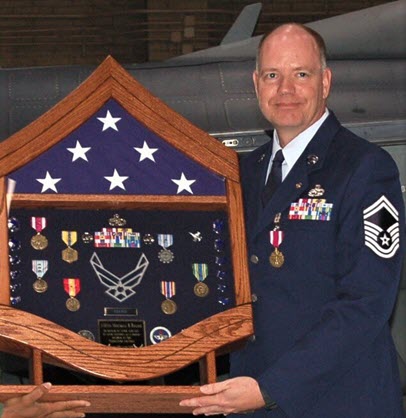
The above article was written by Mitch Boling. Mitch retired from the USAF after 25 years as an F-16 maintainer. In his career he was fortunate enough to fly in this jet three times, and he documents all three experiences in his book, Leadership: A View From The Middle (found on Amazon). It’s a book about leadership, but it is full of his experiences flying in and working on the F-16.
Disclaimer: The appearance of U.S. Department of Defense (DoD) visual information does not imply or constitute DoD endorsement.

Want More Military Aviation Goodness?
Join us in our private Facebook group where you can enjoy the company of other likeminded military aviation fans, including a growing number of former & current military pilots, Radar Intercept Officers (RIO’s) and Weapon Systems Officers (WSOs).
Plus, get access to our videos and livestream content, all free of charge.
Click this link or the photo below to join.
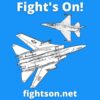
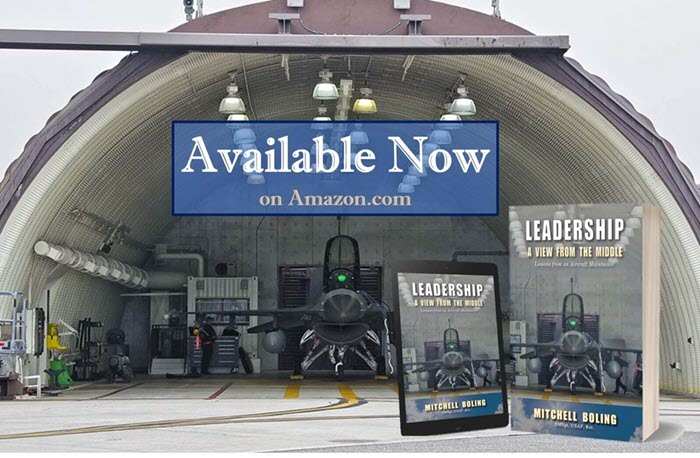
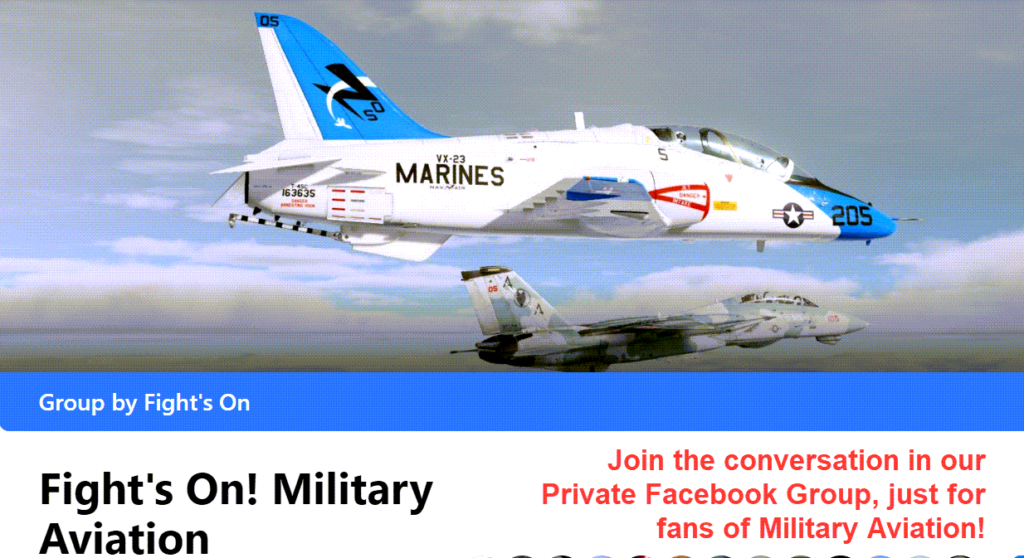
One Response
This picture is from Balad, AB Iraq